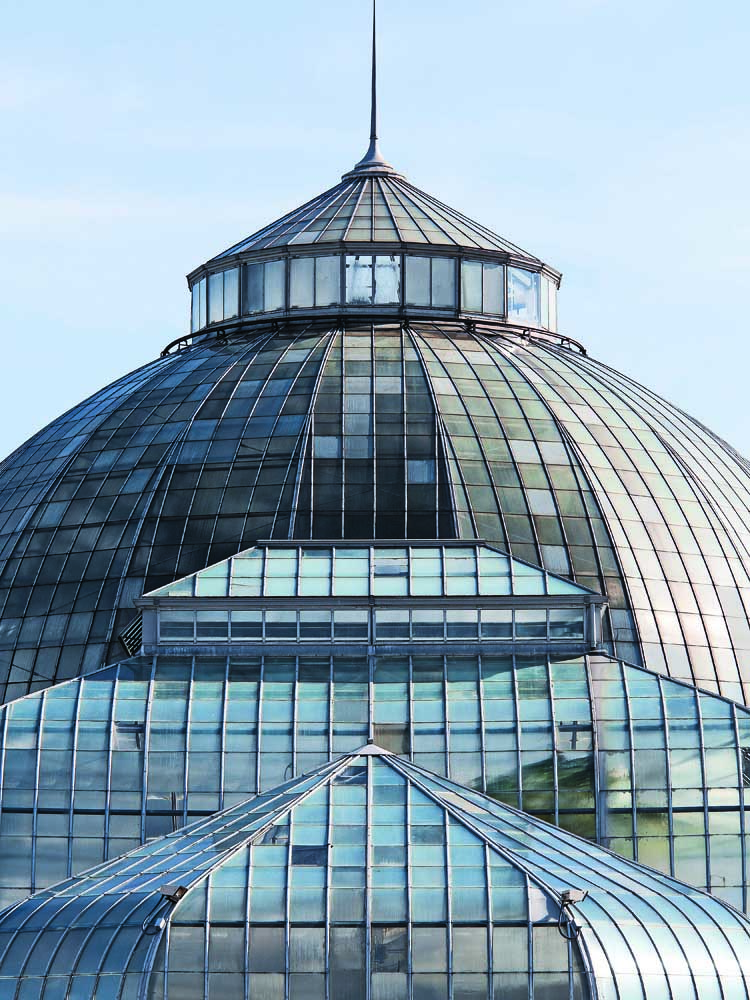Destination Detroit
Published 12:00 am Sunday, April 8, 2018

- The Anna Scripps Whitcomb Conservatory on Belle Isle in Detroit, March 2018. From the Fisher Building to Belle Isle (and beyond), the works of the renowned Albert Kahn endure in Detroit. (Kevin Miyazaki/The New York Times)
On a recent trip to Detroit, I did the one thing that I would never try in New York: I stood on a busy sidewalk and looked up at a skyscraper.
The skyscraper was the First National Building, an attractive 26-story Neoclassical limestone structure downtown near Campus Martius Park. To the outside world, Detroit is known less for its architecture than for its revitalization efforts, which are spreading farther into the city from the downtown core. But as someone who likes to dig a bit deeper, I put the building’s address into my phone to see what would appear.
Names like Cadillac Place and the General Motors Research Laboratory appeared in my search results, and I sought out the connection.
For much of the early 20th century, Michigan was the industrial capital of the United States. The development of the Ford Model T, regarded as the first affordable automobile, and the images of men building cars on moving assembly lines captured the public imagination. As the automotive industry transformed Detroit’s economy, the city’s population grew, increasing from roughly 285,000 residents in 1900 to more than 1.6 million residents by 1940.
During these decades, ornate office buildings, regal academic buildings and grand manors sprouted across the city and the region, largely because of the ingenuity of Albert Kahn. Kahn, frequently referred to as “the architect of Detroit,” designed between 400 and 900 buildings in Detroit, including the First National Building.
‘Ambition and hard work’
Albert Kahn was born into a Jewish family in 1869 in Germany. He immigrated to the United States in 1880, settling in Detroit. Kahn worked odd jobs to help support his parents and seven siblings, ultimately landing a position as a draftsman at the office of the architect George D. Mason, despite only having a seventh-grade education.
“Kahn is one of the last generation of apprentice architects who just came up by working in an office,” said Michael H. Hodges, a writer at The Detroit News and the author of the coming book “Building the Modern World: Albert Kahn in Detroit.” “Mason really took a shine to him and saw his intelligence, ambition and hard work.”
In 1891, Kahn won a scholarship to study abroad, traveling across Europe and sketching architectural details alongside Henry Bacon, who would go on to design the Lincoln Memorial in Washington. The experience was a defining event in Kahn’s life, along with the founding of his own firm, Albert Kahn Associates, in 1895. Kahn designed nearly 2,000 buildings around the world during his career (he died in 1942).
Now, after decades of relative anonymity in architectural conversations, Kahn’s outsize influence is again in the spotlight.
Claire Zimmerman, an associate professor of architecture and art history at the University of Michigan, who is working on a book about Kahn, said he was different from contemporaries like Frank Lloyd Wright.
“Kahn is striking for the fact that he’s so low-key and his immense talents were hidden behind a quite conventional persona,” she said. “I think that’s true of the buildings, as well. The buildings are conventional-looking and that tends to throw you off the scent in terms of their innovation and modernity.”
Much of Kahn’s legacy is on display in Michigan, from the old banking corridors in downtown Detroit to the lavish architecture in suburban Grosse Pointe Shores to the collegiate landscape of the University of Michigan in Ann Arbor. I wanted to see how Kahn revolutionized architecture and had an enduring impact on design, and so I devised my tour of some of Kahn’s most significant works.
Mack Avenue, which runs northeast from midtown Detroit and gradually approaches the city of Grosse Pointe, is an area of deep contrasts. One side of Mack features neighborhoods on the East Side of Detroit, many of which have fared slightly better than large swaths of the city, but whose fortunes have yet to recover from years of economic decline.
On the other side of Mack Avenue is Grosse Pointe, which is surrounded by four cities: Grosse Pointe Farms, Grosse Pointe Park, Grosse Pointe Shores and Grosse Pointe Woods.
When it was developed, the Grosse Pointe area was the epitome of upper-crust society, with Tudor Revival and classic American Colonial architecture. It is decidedly affluent, with quiet, leafy streets with English names like Kensington and Yorkshire. Closer to Lake St. Clair, large estates dot the shoreline.
At the northern end of Grosse Pointe Shores is the Edsel and Eleanor Ford House, completed in 1929. The grounds, designed by the Danish-American landscape architect Jens Jensen, has an island bird sanctuary, lagoon and gardens.
The Fords
Edsel and Eleanor Ford raised their four children in the elaborate home, built in the English Cotswold style. Edsel Ford, the only child of the auto baron Henry Ford, and the president of the Ford Motor Co. from 1919 to 1943, became so fond of the architecture of the Cotswolds when he visited England that he planned the construction of his home in this style. For the design, Ford turned to his close friend Kahn, whom his father had worked with for years, beginning with the Highland Park Ford Plant.
After seeing the Ford House, I wanted to get a sense of how Kahn designed some of his more prominent public buildings.
I headed to Belle Isle, a 982-acre island park in the Detroit River. As I navigated the wide streets, a greenhouse-style building came into view — one of Kahn’s more subtle public spaces.
“What stands out with Albert Kahn is his idea of how the riverfront should be used,” said Ryan Patrick Hooper, a journalist at WDET-FM in Detroit, who also gives tours of the Kahn-designed Fisher Building through Pure Detroit, a company and store that sells Detroit-branded merchandise. “He was thinking about altruistic public spaces at a time when there was an industrial-choking waterfront, which was decades ahead of his time.”
Belle Isle Aquarium
The compact Belle Isle Aquarium opened in 1904 and is one of the oldest aquariums in the country. The beaux-arts-style front entrance, featuring dolphins and the seal of Detroit carved in stone, is alluring — but it’s the interior that really reveals Kahn’s breadth of design.
The sleek green opaline glass tiles that form the vaulted ceiling give the sensation that you’re in a distant underwater universe. Fish include speckled damselfish, cichlid, frontosa and smallmouth bass.
The Anna Scripps Whitcomb Conservatory next door, with a greenhouse and botanical garden, is modeled after the long-gone Crystal Palace, the cast-iron and glass space that housed the Great Exhibition of 1851, and the Palm House at Kew Gardens, both in London.
Plants that are prevalent in warmer climates, like the white-haired opuntia of Mexico and the crassula of South Africa, are featured attractions, and the conservatory’s high dome offers a sense of possibility.
The Qube
Back in downtown Detroit, I walked near the First National Building again, glancing across Woodward Avenue, a prominent thoroughfare and the spinal cord of the almost year-old QLine streetcar. The Qube, a modernist 14-story building that was designed and built by Albert Kahn Associates and serves as an operations center for Quicken Loans, caught my eye.
Even though Kahn didn’t design this building (it opened well after his death), his influences are evident. The building, which was renovated in 2011, is utilitarian, with narrow windows and a marble exterior. A few blocks away is the Detroit Athletic Club, a private neo-Renaissance clubhouse that opened in 1915 and was designed by Kahn. The inspiration for the club’s design came from the Palazzo Borghese in Rome.
The lobby of the club, with its chandeliers and wood paneling, was once a grand gateway for Detroit’s elite. (It’s a private club, so I didn’t go any farther.) But for much of the club’s existence, Jews, as well as African-Americans and women, were barred from holding memberships. The club resolved to make an exception for Kahn, according to Hodges and Zimmerman, but he refused.
Roughly 4 miles north of downtown, the New Center neighborhood was a premier retail area before stores began to gravitate to the suburbs. Home to the world headquarters of General Motors from 1923 to 2000, the neighborhood was able to avoid some of the disinvestment that afflicted surrounding areas. Now, like many Detroit neighborhoods, New Center is buzzing with energy.
Fisher Building
The 30-story Fisher Building here is one of Kahn’s most beloved structures: a classic art deco building with an intricate mix of limestone, granite and marble. The building’s construction was financed by the Fisher brothers, who sold their namesake Fisher Body Co. to General Motors. Kahn had virtually an unlimited budget, installing more than 600 bronze elevator doors, both interior and exterior, and 1,800 bronze windows, along with a gilt-tile roof.
The building defies the conventional wisdom that office spaces cannot be inspiring. This was evident from the third-floor overlook of the Fisher arcade, which gave us a view of the frescoes and mosaics that line the ceilings, with images of outstretched eagles that represented American power.
“After four years, I still genuinely enjoy giving tours,” Hooper said. “A lot of the people who come are first-timers or people who haven’t been in decades, and a big part of the experience is surprising people or changing their minds about architecture that’s in Detroit.”
Across the street, the Albert Kahn Building, a limestone 1931 art deco structure, stands somewhat imposingly even though it has only 10 stories. The lower floors of the building once housed a Saks Fifth Avenue store for 40 years. Since 1931, the building has housed the offices of Albert Kahn Associates, but the firm’s offices are moving to renovated space in the Fisher Building this year. Apartments are expected to replace the old office space.
On the tour of the Fisher Building, visitors can see the rooftop of Cadillac Place, once the world headquarters of General Motors. Kahn built a wide, two-story base with four, separate, 15-story buildings, which erased the fortresslike quality that many office buildings possess and allowed for sunlight from different angles.
The first floor of Cadillac Place, which is occupied by offices for the state of Michigan, is open to the public. Italian marble covers many of the walls; the floors are Tennessee marble.
Packard plant
The Detroit region was home to many of Kahn’s industrial laboratories, including the Highland Park Ford Plant, where the Model T was produced, along with the Packard Automotive Plant and the Ford River Rouge Plant in Dearborn. Unfortunately, most of the Highland Park Plant has been razed.
At the Ford River Rouge plant, virtually all of Kahn’s buildings have been torn down or significantly modified. But the Packard plant is still very much visible, with its durable brickwork and the pedestrian bridge over East Grand Boulevard evidence of past economic might.
“It was based on the Packard No. 10 building that Henry Ford hired Albert Kahn to build the Highland Park Plant in 1908,” Hodges said. “The building is interesting because it had no ornamentation whatsoever and was stripped down to the bare essentials to save his client money.”
At its peak, the Packard Plant had 3.5 million square feet of usable space, and it was one the first industrial facilities to use reinforced concrete. There are plans to convert part of the building to office space, but Kahn’s industrial signature will remain. (Pure Detroit offers walking tours of Packard.)
“Kahn truly influenced the modern movement with his industrial work,” said Alan Cobb, an architect who has been the president and chief executive of Albert Kahn Associates since 2013. “[Walter] Gropius and [Ludwig] Mies van der Rohe looked to Kahn for their philosophies. Basically, while they were creating the philosophy behind modern architecture, Albert Kahn was quietly building it.”
That was clear when I entered the Hill Auditorium on the University of Michigan campus in Ann Arbor and heard beautiful crisp notes coming from the stage, acoustics that Kahn must have dreamed of when he designed this facility. The auditorium, which opened in 1913, reminded me of Radio City Music Hall in New York, with its striking main arched stage.
Next to the auditorium is the imposing Burton Memorial Tower, which has a student-run carillon on weekdays. Minutes away, the stately Angell Hall, with its numerous columns, helps define the collegiate atmosphere. The Natural Science building, a short brick building with a dignified, arched entrance, has been a center of learning for decades.
“In the 1920s, Kahn worked with other members of the University of Michigan community to modernize the campus plan as part of the Committee of Five,” Zimmerman said. “The buildings have a consistency to them in terms of how they look, but they also have a functional consistency. They really turned the campus from a 19th-century campus to a much more modern 20th-century campus.”
In Ann Arbor, and in Detroit, Kahn’s buildings not only seem modern — they’re timeless.








